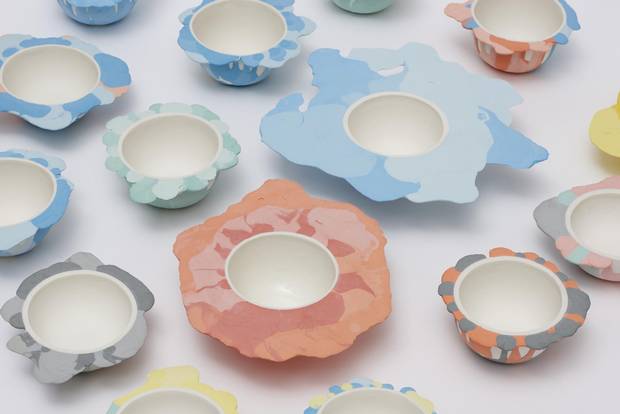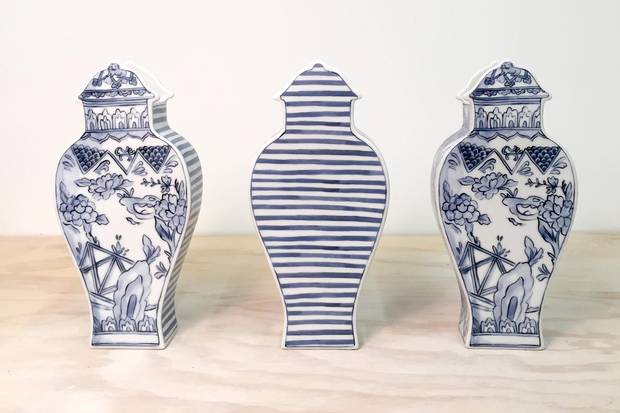Many people think of porcelain as something both precious and passé – the kind of thing our parents and grandparents used to lock up in ornate cabinets, only to be taken out for the most special celebrations (if ever). This perception started millennia ago, with the roots of the craft itself: ceramic arts date back at least 30,000 years (before we lived in cities) with figurines used for ceremonial purposes.
But porcelain persists to this day and continues to evolve, even as fewer people are registering for fine, fussy china when they get married and bulky china cabinets are as relevant as rotary telephones. Contemporary designers are stripping down the frills, amping up the colours and finding new ways for us to enjoy the finery.
Artist and ceramicist Molly Hatch makes whimsical, charming, yet undeniably special pottery for popular brands such as Anthropologie. Her work is dainty yet not too delicate, the kind of thing that brightens any table setting, special occasion or otherwise.
In her new, beautifully illustrated book, A Passion for China: A Little Book About the Objects We Eat From, Live with and Love, she explores the roots of her own fascination with fine ceramics (mainly objects in her grandmother's house) as well as the more immediate enjoyment that well-used porcelain can present (many of her grandmother's things were chipped from being used and not cabineted away – imbuing each piece with loving, happy memories).
"As we move through our daily lives, eating breakfast, sipping an afternoon cup of tea or gathering for a family dinner, the patterned ceramic objects we live with are precious witnesses to our stories," Hatch writes. "We eat from them, they warm our hands after a cold walk outdoors and we pull them out to celebrate the births, marriages and lives of our loved ones."
That human quality is particularly heightened with fine ceramics (as opposed to machine-made, mass-marketed stuff) because the energy, touch and feel of the maker gets transmitted into the material, which itself has an elemental, essential quality.
Martha Grace McKimm co-owns Toronto's popular decor and housewares shop Hopson Grace. The store feels entirely contemporary – suspended orbs of light float through the middle of the store like perfect glowing jellyfish – yet many of the clean-lined, grey shelves are lined with fine china.
It "all counterbalances to what many feel is a soulless consumer landscape," notes McKimm, explaining why porcelain persists at time when everyone wants things to be as microwave-, dishwasher-, and child-safe as possible. "After all, [potters] use their hands and the proverbial 'dirt of the earth' to produce something unique, and that brings context, warmth and a personal touch to a product." Plus, she adds, "Most of the ceramics we carry are actually dishwasher-safe."
Contemporary ceramicist Alissa Volchkova agrees that one of things that's special about porcelain is the personal touch. Volchkova started her career in architecture, but didn't like "working in a field that was more about spending most of the time on the computer, working virtually," she says. She wanted to make things with a "human" quality, and "with spontaneity. … Clay is one of the first materials that can be easily approached by anybody," she says.
But her porcelain is anything but delicate. She makes exuberant cups and bowls, overflowing with colourful, thick blobs – like 3-D, impressionistic oil paintings. "Traditionally, porcelain is supposed to be white, transluscent and shiny, with perfect lines," Volchkova says. "I am doing the total opposite…90 per cent of the people who see my products think that it's plastic or resin."
Her creations would look odd locked up in a display, next to a delicate, 18th-century figurine. But that's exactly the point. It's a different evolution, proof that porcelain has a place out in our kitchens, dining rooms and lives.
Here, seven standout ceramic examples

Alissa Volchkova’s liquid clay creations.
Traditionally, porcelain has been precise – made by hand, usually, but done so exactingly, as if by a machine. London, England-based Alissa Volchkova takes the exact opposite approach. Rather than manipulating the clay into submission, she dyes and pours liquid clay over a cast, celebrating the rough edges and random compositions that results. Price upon request. Through
alissavolchkova.com.
Canadian ceramicist Marjorie Camiré hand crafts her porcelain at her studio in Montreal. The cobalt blue of her bright white vase ($85) references the history of her craft (the hue has been a staple of porcelain since the 14th century) albeit in a relaxed, modern way. Through
en.chicbasta.com.
Spanish designer Jaime Hayon has worked with many notable decor brands, including crystal company Baccarat and porcelain purveyors Lladro, reviving their time-worn crafts with present day motifs and ideas. His Fantasy collection for the latter is like a friendly alien invasion rendered in centuries-old artistry. Price upon request. Through lladro.com.
According to Hopson Grace's Martha Grace McKimm, "as casual dining continues to trend upwards, ceramics' more casual, organic shapes reflect the way we live, eat and entertain." Here, a simple, bell-shaped votive ($20) adds sparkle to any table setting with its simple, though shimmering, twig pattern emblazed. Through hopsongrace.com.
Netherlands-based designer Marcel Wanders often riffs on his country's cultural traditions. For his Blue Ming collection, he plays with the classic blue-and-white patterns of Dutch Delft porcelain. The intentionally incomplete patterning of the serving platter both underscores the intricacy while making it feel less precious. Price upon request. Through vistaalegre.com.
Nymphenburg’s yearly addition to their Skull series.
For centuries, German porcelain manufacturing company Nymphenburg has produced
memento mori – reminders of our mortality. These days, that means a yearly addition to their Skull series, anatomically accurate heads covered in an annually changing pattern. A blend of morbid and marvelous, this year's version features glinting turtles – a reminder to enjoy the bodily pleasures of tropical vacations – before our time runs out. Price upon request. Through avenue-road.com.
American artist and designer Molly Hatch is inspired by the long history of her craft. Her pieces, though, have a contemporary, casual vibe – the illustrations are charming, the shapes are unfussy, making them versatile for everyday use as well as special occasions. Vases from $83 (U.S.). Through shop.mollyhatch.com.



